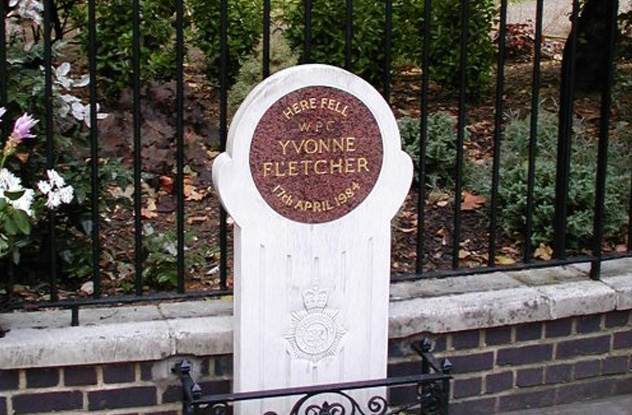 History
History  History
History  Weird Stuff
Weird Stuff 10 Fascinating Things You Might Not Know About Spiders
 Food
Food 10 Everyday Foods You Didn’t Know Were Invented by the U.S. Military
 History
History 10 Odd Things Colonial Americans Kept at Home
 Weird Stuff
Weird Stuff 10 Superstitious Beliefs That Once Consumed Entire Cultures
 History
History 10 Bizarre Friendly Fire Incidents in Military History
 Technology
Technology 10 Modern Technologies That Accidentally Imitate Ancient Magic
 Mysteries
Mysteries 10 Mysteries of the Human Genome
 Weird Stuff
Weird Stuff 10 Things So Rare They’ve Only Been Found Once
 History
History 10 Legends Whose Last Moments Undid Their Glory
 History
History 10 Great Escapes That Ended Right Back in Captivity
 Weird Stuff
Weird Stuff 10 Fascinating Things You Might Not Know About Spiders
 Food
Food 10 Everyday Foods You Didn’t Know Were Invented by the U.S. Military
Who's Behind Listverse?

Jamie Frater
Head Editor
Jamie founded Listverse due to an insatiable desire to share fascinating, obscure, and bizarre facts. He has been a guest speaker on numerous national radio and television stations and is a five time published author.
More About Us History
History 10 Odd Things Colonial Americans Kept at Home
 Weird Stuff
Weird Stuff 10 Superstitious Beliefs That Once Consumed Entire Cultures
 History
History 10 Bizarre Friendly Fire Incidents in Military History
 Technology
Technology 10 Modern Technologies That Accidentally Imitate Ancient Magic
 Mysteries
Mysteries 10 Mysteries of the Human Genome
 Weird Stuff
Weird Stuff 10 Things So Rare They’ve Only Been Found Once
 History
History 10 Legends Whose Last Moments Undid Their Glory
10 Scarily Plausible British Intelligence Conspiracy Theories
There are no shortage of alleged conspiracies about the British establishment. Some of them are implausible, like the RAF causing mass flooding across the southwest of England. Yet we know pretty much for certain that Government Communications Headquarters (GCHQ) collected millions of webcam images from Yahoo customers without anyone’s knowledge (and then estimated that 7.1 percent of these were pictures of genitals). Enough cover-ups are proven that it might not be entirely crazy to suggest some of the shakier ones might be true.
10The Death Of Hilda Murrell

On March 21, 1984, Hilda Murrell was kidnapped from her home, driven away in her own car, and murdered. The 78-year-old was found in a field three days later, beaten and stabbed but actually killed by hypothermia.
In 2005, burglar Andrew George was convicted of the murder after a cold case review found his DNA on evidence. Prosecutors said that George, who was 16 at the time, had panicked during a robbery. Yet many think that this story is very far from the truth and that Murrell’s real killers were MI5.
Murrell was a high-profile anti-nuclear campaigner and had been due to address a public committee the day before her body was found. Nuclear power was a key part of Margaret Thatcher’s energy strategy at the time.
Hilda Murrell also had possible access to a very embarrassing secret. In 1982, the British had sunk an Argentinian ship, the Belgrano. The Brits had declared an exclusion zone around the Falkland Islands, and the vessel was outside that zone. Murrell’s nephew was Commander Robert Green, who knew that the ship had also been moving away from the Falklands. That fact didn’t come out until 1985, and the government tried to prosecute the civil servant who revealed it. If Murrell wanted to embarrass the government, that knowledge would’ve done it.
A forensic scientist who worked on the murder case claimed that a second man’s DNA was found under Murrell’s fingernails, but that information was withheld from the jury that convicted Andrew George. One of George’s former cell mates claimed that George said he’d committed the murder at the request of other men. The cell mate wrote down several names that George had told him. When police received those names, they moved George to another prison and told the cell mate not to mention them again.
At the time of the murder, MP Tam Dalyell told the House of Commons that he believed “men of British intelligence” had been responsible. Robert Green also believes that the UK authorities were behind his aunt’s murder. He has moved to New Zealand but claims that he is frequently monitored and harassed by British intelligence. One of Britain’s most prominent human rights lawyers has called for an enquiry into the death. In 2013, a group of 25 MPs signed a motion in agreement, stating there are “serious and substantial doubts about the criminal investigations.”
9MI5 Founded A Deadly Neo-Nazi Group

Combat 18 (“18” standing for “AH,” Adolf Hitler’s initials) is a British neo-Nazi group founded in 1992. The organization began as an offshoot of the far-right British National Party but split off as an even more extreme group. It recruited from any violent fringe group with far-right sympathies and made itself a home for football hooligans. Their profile peaked on February 15, 1995, when they orchestrated a riot in Dublin that led to the cancellation of a football match between England and the Ireland.
There have been claims that the group was actually set up by MI5. One theory suggests that British intelligence wanted to create a magnet for the most extreme parts of the BNP’s members. One member who was convicted of murder in 1998, Charlie Sargent, has been implicated as an MI5 informant.
A case has also been made that C18 was a roundabout way to infiltrate loyalist terror groups operating in Northern Ireland. Many British right-wing groups supported the loyalist cause in theory, but C18 went out of their way to help. In 1993, a member was arrested delivering handguns, and a year later, another was arrested delivering submachine guns and a rocket launcher to the Ulster Defense Association. Officials deny that the close relationship had anything to do with an MI5 honeytrap plot.
8Death Of “Buster” Crabb

Lionel “Buster” Crabb was a British diver whose work clearing underwater mines during World War II made him a national hero. Yet he is best remembered for the controversial circumstances surrounding his death.
In the 1950s, Crabb undertook work for the UK intelligence services examining Soviet vessels that docked in the UK. He disappeared on April 19, 1956, during a mission for MI6 to investigate a Russian cruiser docked in Portsmouth Harbor. The Ordzhonokidze had brought the leader of the Communist Party and the Premier of the USSR to England for talks with the British Prime Minister. Crabb attempted three dives and encountered difficulties. He didn’t return from the third.
Authorities tried to hide that any dive had taken place. Police removed pages from the check-in book of a local hotel where Crabb had been staying with his presumed MI6 handler, which only increased suspicions. The British Admiralty made an official announcement that Crabb had been testing diving equipment when he failed to return.
When questioned in parliament, Prime Minister Anthony Eden said, “It would not be in the public interest to disclose the circumstances in which Commander Crabb is presumed to have met his death.” He then added that whatever might have happened had been without the approval of government ministers. Files released in 2006 showed that the intelligence services had been told not to investigate the ships.
A headless body wearing a diving suit that matched Crabb’s turned up 14 months later. Positive identification wasn’t possible, but a coroner stated that the body was almost certainly Crabb’s. Yet the British intelligence services have been subject to much more damning accusations over the death than a spying mission gone wrong. A former diving partner of Crabb, Sydney Knowles, believes that the war hero may have been killed by MI5 for threatening to defect to the USSR.
Knowles said that Crabb had become very bitter about difficulties securing a full-time job, and described his options as “either suicide or bloody Russia.” Knowles reported his friend to MI5 and refused to join him on the Ordzhonokidze dive. Crabb had informed Knowles that he’d been given a new diving partner, and papers that were declassified decades later confirmed that Crabb wasn’t diving alone. Knowles summarized the situation, saying, “Our heroes were our heroes, and we couldn’t have a war hero defecting.”
7Killing Lumumba

In 2013, British politician Lord Lea made a controversial claim in a letter to the journal London Review of Books. He said that his friend and fellow lord, Baroness Daphne Park, had admitted to organizing the death of Patrice Lumumba, the first prime minister of the Democratic Republic of the Congo (DRC).
Lumumba’s death has long been pinned on the US and Belgium. The DRC gained independence from Belgium on June 30, 1960, with Lumumba as its prime minister. The country’s Katanga province declared independence from the DRC 11 days later, plunging the new state into a violent crisis. Rebellions elsewhere, combined with a passive UN, forced Lumumba to turn to the Soviets for help. The West, spooked, feared a Soviet foothold in resource-rich central Africa. Lumumba had to go.
Daphne Park eventually became controller for the entire Western Hemisphere, making her the highest-ranking woman in British intelligence. In 1960, though, she was a field agent in Congo. The CIA’s man on the ground rejected Langley’s suggestions to kill Lumumba (with snipers and poisoned toothpaste). It wasn’t necessary—Lumumba was given over to Katangan rebels and was killed by firing squad on January 17, 1961.
According to Lord Lea, when he asked Baroness Park about it, she remarked “We did. I organized it.” The Congolese politicians who’d given Lumumba to the Katangans had links to UK intelligence. MI6 haven’t denied the claims—they call them “speculative”—and the files remain firmly shut.
6The Sinking Of The MS Estonia

The sinking of the cruise ferry MS Estonia in 1994 killed 852 people, making it one of the worst shipping disasters in history. Investigators found that the disaster was caused by the bow door coming loose in heavy waves and the ship letting in water. The ferry, designed to operate in coastal waters, was not suited to open Baltic Sea conditions.
The Swedish government promised to raise the wreck, which had sunk in international waters, but it changed its mind. In 1995, an agreement was signed by six countries with Baltic coastlines, including Sweden, Finland, Estonia, Latvia, Denmark, and Russia. Yet there was a seventh signatory, the UK, who didn’t appear to have any connection to the ship at all.
In 2005, a former sea customs officer in Sweden reported that in the weeks leading up to the sinking of the Estonia, he’d received a command to allow certain vehicles to enter the country without being searched. He stopped the vehicles anyway, telling the driver that he was performing a fake search. He opened a few boxes and believed the contents to be military electronics. At the time, Estonia (the country) was being used as a gateway for Western intelligence agencies to smuggle Soviet technology to the West following the breakup of the USSR. Estonia the ship was apparently being used as a carrier.
A report in British magazine New Statesman the same year said that a source within MI6 had confirmed that the British secret service was working with the Swedes to smuggle items. The Russians weren’t happy about it and threatened to sink the ship if activities continued. The Western agencies believed that ship served as a shield and the Russians were bluffing. The Russians weren’t, and they planted a mine on the vessel.
A seaman who survived the sinking later reported hearing a loud bang shortly before the ship toppled over. Investigators from the yard that built the ship also favored the explosion theory. An American salvage expert, Gregg Bemis, was able to examine the ship briefly in 2000. He sailed from Germany, and his team of divers recovered metal from the hole in the bow. They claim that lab tests suggest that it had been subject to a high-velocity explosion.
The Swedish navy prevented Bemis from completing further dives and issued a warrant for his arrest should he ever set foot in the country. The US State Department also told Bemis to back off from exploring the wreck, while journalists in Russia have faced similar pressure from their government.
5MI6 Funded An Al-Qaeda Assassination On Gadhafi

In February 1996, a bomb was planted under a car that was part of Colonel Gadhafi’s motorcade. It was intended to kill the Libyan leader, but he was in another vehicle. Several bodyguards were killed, and a gun battle afterward killed several Islamic extremists. The would-be assassins had links to Al-Qaeda.
The head of the Libyan desk for MI5 at the time was an agent named David Shayler. In 1997, Shayler left the service and leaked information to the press. He was forced to flee to France, and in 1998, he claimed that the plot to kill Gadhafi had been funded by MI6.
In joint meetings with MI6 in the months after the attempt, Shayler said that he learned of an operative codenamed Tunworth. Shayler’s equivalent in MI6 was David Watson, who revealed that they’d channeled £100,000 ($170,000) to Al-Qaeda. Foreign office ministers denied giving any go-ahead for a murder attempt.
Libya issued an Interpol arrest warrant for Osama Bin Laden in March 1998. In 2002, a pair of experts on French intelligence claimed that the British, in collusion with US intelligence, played down the threat from Al-Qaeda to prevent an arrest. The British also gave asylum to Anas Al-Liby until 2000, when he fled abroad. The French authors claim this was to prevent details of MI6’s involvement in the Gadhafi plot from being revealed in court.
4Death Of Airey Neave

During World War II, Airey Neave became famous when he performed one of the most spectacular prison escapes of the conflict. He broke out of the infamous Colditz prison and spent four months crossing Europe on foot before finally making it back to Britain. After the war, he became a politician and won a parliament seat in 1953. In the afternoon of March 30, 1979, a car bomb on his vehicle exploded as he was driving from the House of Commons car park.
He was the Shadow Northern Ireland Secretary, and the Irish National Liberation Army claimed responsibility for the attack. Margaret Thatcher came to power later the same year, and Neave had promised a ruthless campaign against Irish nationalists, including capital punishment for terrorism and a shoot-to-kill policy for British forces.
No one was ever prosecuted for the murder. Some people believe that it was actually carried out by, or with help from, MI6 and the CIA. Enoch Powell, a British MP, gave a speech in 1986 claiming that “MI6 and their friends” were behind the death.
The US allegedly favored a united Ireland. It’s also rumored that Neave, who’d been involved with military intelligence during the war, had intended to clean out and overhaul MI5 and MI6 should he come into office.
3The Yvonne Fletcher Deal

Policewoman Yvonne Fletcher was shot on April 17, 1984 while policing a protest outside the Libyan embassy in London. The bullet came from inside the embassy. British authorities laid siege to the building for 11 days before the 30 diplomats inside were allowed out to return to Libya. No one has ever been charged with the murder.
The British authorities have been accused of being culpable in multiple ways. Records released in 2014 show that British officials were warned twice by Libya that there would be consequences if the protest went ahead. Other files show that the intelligence services believed that Libya may have had assassins and stocks of weapons at their embassy, smuggled via diplomatic bags. Someone from inside the embassy allegedly told a contractor erecting barriers, “We have guns here today. There is going to be fighting, and we aren’t going to have responsibility for you or the barriers.” No precautions were taken against gunfire.
A 2007 review found adequate evidence to charge two men with conspiracy to murder. Neither of them had diplomatic immunity, and they’d escaped before the embassy was surrounded. According to a former British ambassador to Libya, no action was taken because a deal was made not to pursue prosecution during negotiations for hundreds of millions of pounds worth of trade deals. The foreign office denied making a deal, yet an MP speaking on behalf of the Fletcher family said “I think they deliberately misled us.”
2Rosemary Nelson
Over 3,500 people were killed by The Troubles in Northern Ireland. Among them was Rosemary Nelson, a lawyer who defended Irish nationalists in high-profile cases. On March 15, 1999, a bomb exploded underneath her car. A loyalist paramilitary group known as the Red Hand Defenders claimed responsibility.
Nelson had been living in danger for some time. She’d received at least seven death threats over the previous two years. Most disturbingly, two of these were alleged to have come from officers of Northern Ireland’s police force, the Royal Ulster Constabulary (RUC). It became public knowledge that RUC officers had made threatening remarks about Nelson to her clients.
After the assassination, immediate accusations arose of collusion by the RUC and other British authorities. Subsequent revelations showed that MI5 had kept a file on Nelson starting in 1994 and had acquired a warrant to tap her phone. The security service sparked controversy in 2006 by requesting legal representation at a public enquiry due to start the following year, including the ability to review and redact documentation.
It’s almost universally acknowledged that the authorities were negligent in offering protection to Nelson. Multiple human rights charities including Amnesty International had criticized the treatment of Nelson while she was still alive. The result of the public enquiry was that there had been no collusion between authorities and the Red Hand Defenders, but rogue individual officers may have helped make the assassination possible. Many are convinced it went even deeper than that.
1The Overthrow Of Sukarno

Indonesia’s first president, Sukarno, led the independence movement that regained control of the country from the Netherlands in 1949. He spent the next decade and a half plunging the country into chaos, avoiding assassination attempts, and annoying his own army. He took $1 billion from the US before telling them “to hell with your aid,” and in 1965, he vowed to crush Malaysia.
The growing strength of the Indonesia Communist Party alienated the West further, as did Sukarno’s habit of nationalizing their assets in the country. Sukarno also fell out of favor with the Indonesian army. A general named Suharto took Sukarno into the army’s “care,” and by 1967, he was the country’s dictator. Suharto’s rule saw the deaths of at least 500,000 Indonesians and a deadly war with East Timor, which killed over 230,000 civilians.
A British Foreign Office agent named Norman Reddaway worked with MI6 and GCHQ in Indonesia in the early 1960s. He claims that he was told “to do anything I could do to get rid of Sukarno” and given a budget of £100,000. GCHQ intercepted communications from Sukarno and passed them to his enemies in Suharto’s military. Psychological warfare officers spread propaganda against Sukarno’s rule. The CIA tried to help by creating a fake pornographic film with a Sukarno look-alike, but that didn’t go so well. The British Foreign Office officially denies any involvement in the overthrow.








